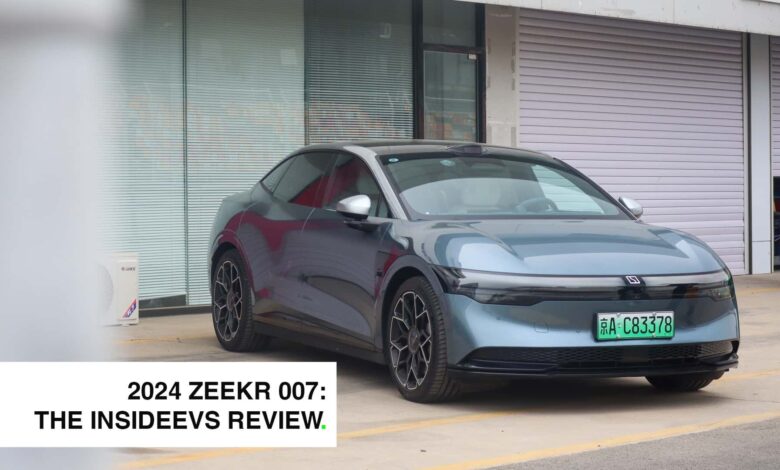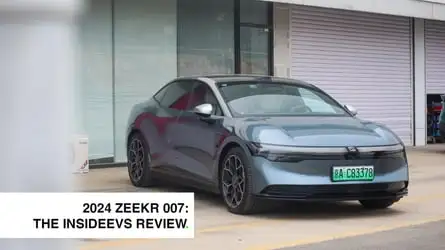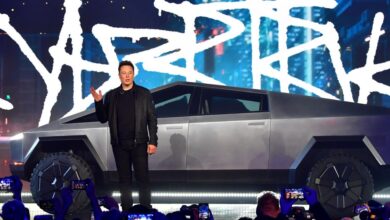This $36,000 Tesla Model 3 Competitor Proves We’re Cooked

Geely’s midsize electric sport sedan charges fast, drives well, and feels great. Western automakers: This is what you’re up against.

Even before the advent of mass-produced electric cars, some critics have insisted that too many new cars just look and feel the same—especially if they’re from the same parent company. To them, all these modular platforms with unmemorable names like TGNA and MQB just yield the same car over and over again; it’s even worse with EVs since batteries, motors and software don’t create as many obvious differences as engines do.
I think that’s a little hyperbolic and far too pessimistic. There are plenty of things engineers can do to make vehicles feel different from each other, even if the vehicles themselves must share some common parts. That’s what separates the wheat from the chaff when it comes to a good car company.
Still, when I knew I’d be venturing to China to sample nearly all of the cars on Geely’s new modular EV platform, I had my reservations. I’ve driven lots of EVs from Volvo and Polestar before. Would I be flying 6,000 miles to essentially drive the same car damn near a dozen times?
Thankfully, that wasn’t the case. Geely’s figured out a way to craft a modular platform that is flexible enough for its end products amongst its too-many brands to have a different feel; the budget and pint-sized Smart #3 doesn’t feel like the Panamera-inspired Zeekr 001. The Honda Accord-priced Geely Galaxy E8 might as well be on a different planet from the super-luxe Lotus Eletre. But while sampling a fleet of generally well-resolved EV and PHEV models from the Geely group, one stood out as the surefire best-in-show: The Zeekr 007.
I’m gonna go ahead and say it. If it had a foreign badge or was sold widely outside of Mainland China, it would probably be some publication’s Car Of The Year. And I ain’t just saying that; it’s genuinely a good car, with a smartly-designed platform. It bodes well from what we’ll see next from Geely’s tie-ups with brands like Volvo, Smart, Polestar, and potentially more.
(Full Disclosure: The Zeekr 007 was tested amid a reporting trip to the Beijing Auto Show, where Geely provided travel and lodging.)
| 2024 Zeekr 007 | |
|---|---|
| Base Price | $29,595 (209,900 CNY) |
| Battery | 75 kWh (LFP) |
| As-Tested Price | $36,645 (259,900 CNY) |
| EV Range | 383 Miles (616 km, CLTC) |
| Output | 637 hp |
| Maximum torque | 523 lb-ft |
| Drive Type | dual-motor, AWD |
| Speed 0-62 MPH | 3.8 seconds |
| Charge Time | 311 miles in 15 minutes, 500 kW peak speed |
What the Heck is a Zeekr?
Zeekr is a brand that supposedly sits below Polestar in the Geely family, but both claim to be Sino-Swedish brands with a lot of their design and engineering work done in Gothenburg, Sweden. Then, there’s a third one called Lynk & Co, which also is a premium brand that says it’s Sino-Swedish in origin; what the heck is going on here?
Geely says that Zeekr is meant to chase brands like Audi and Acura (now defunct in China), while Polestar aims for Porsche. It’s not clear if there’s actual space for all three brands, because even under the Geely umbrella, there are some winners and losers. Zeekr outsells Polestar two-to-one globally, and its stock price has held fairly true since its recent IPO offering in May. It’s doing well there, too. By comparison, Polestar is fighting to not be delisted from the New York Stock Exchange.
Still, those things are probably immaterial to the end consumer who probably isn’t an investor. The Zeekr 007 and Polestar 2 are both kinds of Tesla Model 3 competitors, but at its core, the Zeekr feels a little bit more of a direct competitor, than the hatchback crossover like Polestar 2. The Zeekr 007 is a four-door, five-passenger sedan with no crossover pretense, priced directly against the Model 3.
Underneath, the Zeekr 007 rides on a variant of the Geely SEA (Sustainable Experience Architecture) platform – a hyper-modular platform Geely wants to see used on as many of its brands as possible, including the Volvo EX30 and Polestar 4. Geely’s engineers say that there’s plenty of leeway with regards to making SEA as modular as possible. It can be as advanced or budget as it needs to be. For example, the refreshed Zeekr 001, 009 (and mechanical twin, the China-only Volvo EM90), and now this 007 use mega casted one-piece rear sections of the frame that the brand claims reduce cost while adding vehicle rigidity. Other variants, like the Polestar 4 or Geely Galaxy E8, do not use this technology.
The Zeekr brand is not sold in the U.S. thanks to tariffs on Chinese EVs, but it is coming soon to Mexico. And I get the sense Geely would give it a shot if things ever changed here; let’s just say this won’t be the last you’ve heard of this company.
And, wow, the car is a looker. The car is both futuristic while being unpretentious or overwrought. The Zeekr 007’s sleek lines yet interesting surface translations are stunning in the metal. The 007’s side profile is nearly completely unencumbered by any surfaces, heck, Zeekr even opted to move to electronic buttons for all but the topmost trim, adding to the smooth and sleek design. The 007 has road presence, it feels low and wide, but not so much that it’s a sort of impractical caricature that’s too wide and too compromised to ever be of use or fit real passengers.
Dimensionally, the 007 is a little bit bigger than a Model 3. At an overall length of 191.5 inches, the 007 is about six inches longer than the Tesla, and part of that is due to the Zeekr’s two-inch longer wheelbase. The Zeekr is also about half an inch taller than a Model 3, too. Compared to the Polestar 2, the Zeekr 007 is about 10 inches longer, with seven of those inches going straight to the car’s wheelbase.
Up front, a whole light bar goes across the front of the vehicle. Dubbed the “Stargate Panel,” this LED is made by Valeo and features 1,700 LEDs, that can do customized patterns and messages set by the driver. At the back, thin running lights sit atop the clamshell trunk above a wave pattern embossed into the trunk decklid.
It’s just a nice-looking car. It’s sort of reminiscent of, say, the Lucid Air, but in a shorter, sportier, more jovial package. The 4WD Performance edition only enhances that: an active spoiler, ground effects kit, and special wheels make the 007 look positively lithe. Add in the cheekily-named Kung Fu Yellow Paint and gloss black accents, and it’s clear Zeekr wants the 007 to be the electric car embodiment of Bruce Lee and his iconic yellow jumpsuit.
But the interior is where the Zeekr 007 sprints away from Tesla and its fellow cousin from Polestar.
Tap one of the electronic release circles on the B or C pillars, and then step down into the 007’s cabin, and you’ll be greeted with an interior that feels both fresh and genuinely expensive.
Whereas Polestar’s a-little-too-close-to-Volvo design ethos can result in an interior ambiance that’s both stiff, square, and hard, the 007’s interior feels round, soft, and plush. The 007 is bouba to the Polestar’s kiki; the seats are soft, the dashboard is soft, and there are no sharp edges in the 007. Even the driver’s display cluster is rounded.
All of the plastics meant to be touched, feel soft and expensive. Even the headliner, a place where most wouldn’t even pay much of any mind, is covered in an Alcantara-like material. It’s certainly nicer than what you’d get in any equivalent Tesla, Acura, or dare I say it, Audi. It even had Nappa leather seats.
Everything inside feels thoughtful. Emblazoned on the sill panels is a “styled in Gothenburg” placard, so on some level the Zeekr would follow some of that same Scandinavian minimalist theme that we’ve seen at Volvo and Polestar. Yet, Zeekr’s take feels so much more ornate. There are more interesting interior design choices than the standard grey, white, and accented seatbelts we’d find in Volvo or Polestar.
The car on test had a blue and white interior, with rose gold interior brightwork present throughout the cabin., The fact that we got switches on the doors in the usual places is a miracle; the 007 avoids feeling too paired back, as there are a few switches (either physical or touch screen digital) always in the correct place.
Of course, a lot of Chinese EVs do look impressive on paper. They even feel convincing when touched. But when it comes to driving them, some say that the driving experience doesn’t necessarily keep up with the rest of the car.
Good news, though. That ain’t the case here with the Zeekr 007.
The Zeekr 007 Is Fantastically Composed
The Geely Driving Experience would take place at Beijing’s Goldenport Circuit, a somewhat tighter circuit that is biased toward cornering ability, rather than outright speed. Hell, the circuit’s best time here belongs to a front-wheel-drive WTCC car, not a lightning-fast rear-wheel-drive supercar.
Geely let me do a couple of laps at maybe half to ⅔ tilt with a fellow international journalist in the passenger seat. We went round-robin style, sampling more than a dozen of Geely’s latest cars from all of its brands (except Polestar and Volvo) – electric, PHEV, and even one gas-powered Lynk & Co 03 TCR sedan. We’d each get a lap or two in the car, before switching off to the next vehicle.
Maybe a lap or two is enough for some other person to form a fully fleshed take, but it isn’t enough for me. I need more time with the car, I talked the Geely staff into letting me do three laps in the 007 at full send. Alone.
On the track, I quickly reached speeds of about 120 mph along Goldenport’s back straight, an easy thing to do with 637 horsepower on tap. Then I’d brake hard, and trail brake through a bit of the curve, clipping the apex of turn 12’s tight left turn. I’d mat the throttle, blasting through Goldenport’s turn 13 and 14 chicane before looping around back to the starting line.
The 007’s dynamics were level-headed, not upset by any sort of (moderate) pitch correction or chassis upsets inherent to manhandling a not-so-light luxury sedan around a tighter, somewhat technical course. The car felt well-sorted, agile, and approachable; the 007 has a lot of power and grip, but it never once felt like a widowmaker, nor a video-game-like bore.
It just felt downright fast, akin to the first time I drove and fell in love with the Lucid Air. It was so fast that, multiple times during my single-driver lead-follow laps, I had to back off because I was getting a little too close to the professional drivers in the Zeekr 001 in front of me.
It was an enjoyable car, and I was very upset that I couldn’t get a few more laps in. The 007 took everything I liked about the 001 I drove in October but put it in a package that just felt so much more on the ball. Whereas the 001 sort of feels like a low-slung crossover emulating a car, the 007 feels like the sporty premium sedan it’s aiming for.
The variant I was driving was called the “Intelligent Driving Version 4WD ” which is the most expensive variant one can buy in China next to the topmost 4WD Performance version. It costs 259,900 CNY, or $36,629 at current U.S. exchange rates. By comparison, this is about $1,500 cheaper than an equivalent dual-motor, AWD long-range Tesla Model 3 in China. Zeekr says it is good for 383 miles of range, on China’s CLTC cycle.
The Zeekr owner will get an 800V architecture, a 75 kWh LFP battery, that can peak at a staggering 500 kW at a DC fast charger – Zeekr says it can add 310 miles of range in as little as 15 minutes. That battery feeds 637 horsepower’s worth of electric motors, all held up by fancy electromagnetic dampers. The zero to 100 km/h run (zero to 62 mph) comes in about 3.8 seconds, according to Zeekr.
Of course, every electric car is damn near fast, unless it’s a normal-trim version of the Chevrolet Blazer, Bolt, or Equinox for some reason. The Zeekr 007 is no exception. Full-throttle launches will pin all occupants to the back of their respective seats like any car with more than 600 available at the driver’s right foot should be able to do. It’s fun, but that’s not really unique in the EV realm, is it?
No, the testament to how good a car truly is, is how well it manages its weight and power levels, something the 007 is good at doing. EVs are generally heavier than a comparable gas-powered car. Creating a chassis and suspension setup that can rein in all that weight without a car feeling dim-witted or poor riding isn’t easy, just ask Chevy and its bouncy-riding Blazer, or drive the surprisingly cumbersome BMW i7.
Even amongst other Geely group platform siblings I had driven that day, the 007 stood out. The refreshed 001’s revised chassis and suspension fixed the issues I had with the one I drove in New York, but that car didn’t feel as spry as the 007. The Smart #3 Brabus was entertainingly tail-happy, but dynamically it didn’t feel as sophisticated as the 007. The Zeekr X certainly had a comfy ride, but it felt like it came at the expense of all handling chops whatsoever. Hell, even the slightly tangentially related Lotus Eletre didn’t feel like it was handling its 905 horsepower as well as the 007.
A Very Tough Competitor
Of course, a glowing on-track event is only one aspect of a vehicle’s overall ownership experience. For all I know, the 007’s 500kW max charging speed might as well be a myth. Or, it could be a total energy hog and not even remotely achieve its 383-mile rating. Also, since all of the infotainment settings were in Chinese, I don’t know how good or bad Zeekr’s system is, even though I do know that Nvidia is supplying the chipset for that system.
But from what I can see and evaluate, Geely and Zeekr have created a stunning car. If any of the Western automakers had released a car this thoughtful and well-resolved, EV conversations would revolve less around brands desperately figuring out how to move metal or increase sales, and rather toward which models are the most desirable. It’s certainly better than any Car of The Year contender I’ve driven so far.
I said it before, and I’ll say it again: if non-Chinese automakers don’t get it together, then they really are cooked. The Zeekr 007 is a class act. Even if Zeekr were to add more than $10,000 to the 007’s price, it would be a strong offering in the U.S. compact EV luxury segment. It’s better looking than the Mercedes-Benz EQE. It has a much nicer interior than the Tesla Model 3. Heck, even in the Geely umbrella, the Polestar China is charging more than $5,000 more for a worse car; the Polestar 2 isn’t as nice or as refined. This could point to some sort of infighting at the Geely group brands, but I digress.
Despite going public at the NYSE and even entering Mexico, it’s kind of a snowball’s chance in hell that Zeekr will ever come to the U.S., largely in part due to the Biden Administration’s new 100% tariffs on imported Chinese EVs. But the Zeekr 007 certainly proves that the SEA platform is certainly a good base for Volvo, Polestar, and anyone else to use.
If the SEA-based cars that Geely plans to sell out of its new South Korean plant are all this good, then the rest of the industry better watch out.
Because they’re coming for blood.
Contact the author: kevin.williams@insideevs.com
Read more



